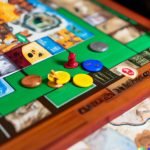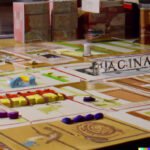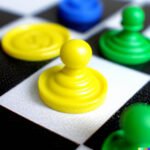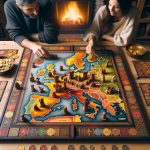Are you a fan of board games? Do you enjoy the challenge and camaraderie that come with sitting down at the table for a good old-fashioned game night? If so, then you’re in for a treat.
In this article, we will be delving into the world of classic European board games and exploring their rich history, cultural impact, and timeless appeal. Get ready to discover 4 classic European board games that have stood the test of time and continue to captivate players of all ages.
From ancient strategy games to modern favorites, European board games offer a diverse array of experiences that have been enjoyed for centuries. We’ll take a closer look at the origins and evolution of traditional board games in Europe, tracing their roots back through the annals of time. You’ll gain insight into how these beloved pastimes have shaped European society and beyond, leaving a lasting impression on culture and entertainment.
But what are these 4 classic European board games we’ll be exploring? Chess, Backgammon, Catan, and Carcassonne each hold a special place in the hearts of players around the world. These timeless classics offer unique challenges and thrills that have kept enthusiasts coming back for more.
Whether you’re a seasoned pro or new to the world of board gaming, there’s something for everyone to appreciate in these enduring favorites. So get ready to roll the dice, move your pieces strategically, and embark on an adventure through the fascinating world of classic European board games.
The History of Board Games in Europe
Origins of Traditional European Board Games
- Senet: This ancient Egyptian game is one of the earliest recorded board games in history, dating back to around 3500 BC. It was a game of strategy and luck, played on a grid with pieces moved according to the roll of dice.
- Royal Game of Ur: Also known as the Game of Twenty Squares, this ancient Mesopotamian game was played on a distinctive board with two sets of pawns. Historians believe it may have influenced the development of Backgammon.
- Tafl Games: Popular among the Norse peoples, Tafl games were a family of ancient Germanic and Celtic strategy board games. These games were often associated with military strategy and tactics.
Evolution of Traditional European Board Games
Over time, these early forms of board games developed into a wide variety of classic European board games that are still played today. Chess, for example, can trace its roots to ancient Indian and Persian predecessors before becoming popular in medieval Europe.
Backgammon also has a long history, with origins in early Mesopotamia before spreading across Europe and becoming a staple in Mediterranean cultures. Even modern classics like Catan and Carcassonne draw on traditional elements from European history and culture in their gameplay.
The rich tapestry of traditional European board games reflects not only the leisure activities enjoyed by past generations but also offers a glimpse into the social dynamics and values that shaped European societies throughout history.
Chess
Key Elements of Chess
- Board: A square board with 64 squares, arranged in an 8×8 grid.
- Pieces: Each player starts with 16 pieces, including a king, queen, bishops, knights, rooks, and pawns.
- Strategy: Players must use tactics such as pinning, forking, and skewering to outmaneuver their opponent and checkmate the enemy King.
Chess has endured for centuries due to its timeless appeal as a game of strategy and patience. The mental challenge of predicting your opponent’s moves while strategizing your own makes chess a beloved game not only in Europe but worldwide. In addition to being an entertaining pastime, chess has been proven to enhance cognitive skills such as memory, concentration, and problem-solving abilities.
Tips for Playing Chess
- Control the center of the board
- Protect your King
- Use your pawns strategically
Whether played casually at home or in competitive tournaments, the allure of chess lies in its ability to captivate players with its complexities and challenges. This classic game continues to be revered for its intellectual stimulation and enduring legacy throughout European history.
Backgammon
The objective of backgammon is to move all your pieces around the board and bear them off before your opponent does the same. Players take turns rolling dice and moving their checkers accordingly. With elements of strategy in blocking your opponent’s moves and maximizing your own, as well as an element of chance in the roll of the dice, backgammon offers a dynamic and engaging gameplay experience.
In Europe, backgammon has not only been enjoyed for its entertainment value but also for its social aspect. Many cafes and clubs across European cities host backgammon tournaments, where players can showcase their skills and connect with fellow enthusiasts. The game’s enduring popularity in Europe has cemented its status as one of the classic European board games that continues to be cherished by people from all walks of life.
| Backgammon | Classic European Board Game |
|---|---|
| Game Objective | Move all checkers around the board and bear them off before the opponent |
| Elements | Strategy, probability, luck |
| Social Aspect | Hosts tournaments at cafes and clubs across European cities |
Catan
One of the key factors contributing to Catan’s success is its accessibility. Unlike traditional European board games that may have complex rules and lengthy gameplay, Catan is relatively easy to learn and can be enjoyed by players of all ages. This has made it a popular choice for families and casual gamers looking for an engaging yet approachable gaming experience.
The impact of Catan on European society cannot be understated. Its widespread popularity has led to the creation of numerous expansions, spin-off games, and even a World Championship competition. Additionally, the game’s influence has extended beyond the realm of board gaming, inspiring video game adaptations and merchandise. As such, it comes as no surprise that Catan continues to maintain its status as a modern classic that captured the hearts of Europeans and gamers worldwide.
| Catan Stats | Fact |
|---|---|
| Year First Published | 1995 |
| Game Designer | Klaus Teuber |
| World Championship Competition | Yes |
Carcassonne
Carcassonne is a tile-placement game that takes its players back in time to the medieval world of southern France. This classic European board game, named after the fortified city of Carcassonne, allows players to create a landscape with cities, roads, fields, and monasteries by strategically placing tiles. The game’s simple mechanics and engaging gameplay have made it a favorite among board game enthusiasts for over two decades.
In Carcassonne, players take turns drawing and placing tiles and then decide whether to place a follower on the tile they just placed. The goal is to score points by completing cities, roads, and other features on the map. Additionally, players can earn points by occupying monasteries or completing long roads. The player with the most points at the end of the game wins.
One of the reasons for Carcassonne’s enduring popularity is its numerous expansions and variants that offer new challenges and gameplay mechanics. These expansions allow players to add new features like rivers, traders, or even dragons to their games, providing endless opportunities for replayability.
The Cultural Impact of Carcassonne
Carcassonne has not only captivated board game enthusiasts but has also influenced pop culture and inspired video game adaptations. Its easy-to-learn rules make it accessible to a wide range of players, from families to strategic gamers, contributing to its widespread appeal across Europe and beyond. With its rich historical theme and engaging gameplay, Carcassonne continues to be a beloved classic European board game that captures the imagination of players worldwide.
Cultural Impact
Entertainment and Social Interaction
Classic European board games have had a significant impact on European society, providing a source of entertainment and social interaction for centuries. Games such as Chess, Backgammon, Catan, and Carcassonne have brought people together, fostering camaraderie and friendly competition. These board games are often played in cafes, parks, and community centers, serving as a means of uniting people from different backgrounds and creating a sense of community.
Strategic Thinking and Problem-Solving
Board games like Chess and Catan have influenced European society by promoting strategic thinking and problem-solving skills. Chess, in particular, is revered for its ability to develop cognitive abilities such as critical thinking, foresight, and decision-making. Similarly, Catan challenges players to strategize their resources effectively while adapting to changing game dynamics. These games have not only entertained generations but have also contributed to the intellectual development of individuals across Europe.
Preservation of Cultural Heritage
Carcassonne is a classic European board game known for its unique depiction of medieval landscapes and landmarks. This game has played a role in preserving cultural heritage by introducing players to the historical significance of ancient cityscapes and architectural marvels in Europe. Through playing Carcassonne, individuals gain an appreciation for the rich cultural legacy of the continent while simultaneously engaging in an immersive gaming experience that deepens their understanding of European history.
Through their emphasis on entertainment, strategic thinking, and cultural preservation, classic European board games have left a lasting impression on society both within Europe and beyond.
Tips for Playing
When it comes to mastering classic European board games, it’s essential to have a solid understanding of the strategies and tactics for each game. Whether you’re a beginner or an experienced player, honing your skills can make all the difference in achieving victory. Here are some tips and advice for playing and mastering the 4 classic European board games.
Chess is a game of strategy, patience, and foresight. To become a skilled chess player, it’s crucial to understand the movements and abilities of each piece on the board. Players should focus on controlling the center of the board, developing their pieces harmoniously, and creating potential threats to their opponent’s pieces. Additionally, learning common opening moves and studying famous chess games can provide valuable insights into successful strategies.
For Backgammon, players need to balance luck with skill to achieve success. Understanding how to efficiently move your checkers around the board while avoiding being hit by your opponent is crucial. Players should also aim to block their opponent from advancing their checkers while simultaneously creating opportunities for their own advancement. Taking calculated risks when bearing off can also be decisive in securing victory.
In Catan, resource management is key to building settlements and roads effectively. Players should consider strategic placement of settlements and cities in areas that offer abundant resources like brick and wheat. Trading resources with other players can also be advantageous in acquiring what is needed to expand your settlements further. Keeping an eye on development cards can also swing the tide of the game in your favor.
Finally, Carcassonne is a game of tile placement and area control. Players should carefully consider where to place tiles to maximize points while minimizing opportunities for opponents. Completing cities and roads early can secure valuable points, while strategic use of followers (meeples) can help control territories effectively.
By understanding these tips and strategies for each classic European board game, players can improve their skills and increase their chances of success in these timeless pastimes.
Conclusion
In conclusion, the world of classic European board games offers a rich tapestry of tradition, strategy, and entertainment. From the timeless game of Chess to the beloved Backgammon, and the modern classics Catan and Carcassonne, these games have stood the test of time and continue to captivate players across Europe and beyond. Their enduring appeal lies in their ability to bring people together, stimulate mental acuity, and provide hours of enjoyment.
These classic European board games also hold a special place in the cultural fabric of the continent, reflecting historical periods, societal norms, and strategic thinking. Their influence can be seen in literature, art, and even in shaping diplomatic strategies. By embracing these traditional board games, one can gain a deeper understanding of European heritage while also honing critical thinking skills and cultivating a sense of camaraderie.
As we continue to navigate an increasingly digital world saturated with screens and technology, it’s important to celebrate the simplicity and nostalgia of traditional board games. Whether playing with family or engaging in friendly competition with fellow enthusiasts, these classic European board games offer a timeless escape from the hustle and bustle of modern life. So let’s roll the dice, move our pieces strategically across the board, and revel in the enduring magic of traditional European board games.
Frequently Asked Questions
What Is the Most Famous of the European Style Board Games?
The most famous European style board game is arguably Chess. With its origins dating back to the 7th century, this strategic game has captured the attention of players around the world for centuries. Its combination of simple rules and complex strategies has earned it a reputation as one of the greatest board games of all time.
What Are the Four Categories of Which Classical Board Games Fall?
Classical board games can generally be categorized into four main types: race games, space games, chase games, and displace games. Race games involve moving pieces from a starting point to a finishing point. Space games involve maneuvering pieces within a defined space on the board.
Chase games require one player to capture or “chase” the other player’s pieces. Displace games involve repositioning pieces in relation to each other.
What Is the Main Classic Board Game?
The main classic board game would likely be considered as Chess due to its historical significance and enduring popularity. However, other contenders for this title might include Go, Backgammon, or checkers as they also have rich histories and widespread appeal across different cultures and regions.
Ultimately, the designation of “main classic board game” may vary depending on different perspectives and cultural influences.

I love playing all kinds of games – from classics like Monopoly to modern favourites like Ticket to Ride.
I created this blog as a way to share my love of board games with others, and provide information on the latest releases and news in the industry.





